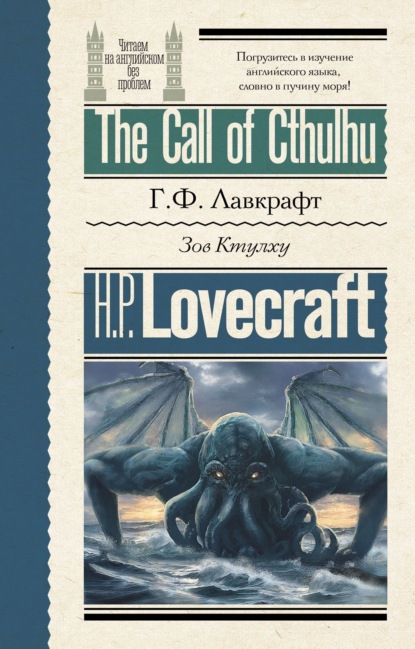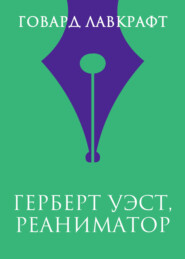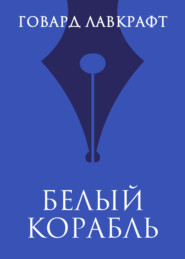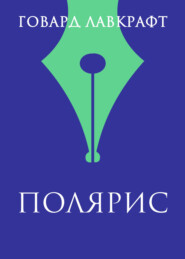По всем вопросам обращайтесь на: info@litportal.ru
(©) 2003-2024.
✖
The Call of Cthulhu / Зов Ктулху
Настройки чтения
Размер шрифта
Высота строк
Поля
One day came rescue – the Vigilant, the vice-admiralty court, the streets of Dunedin, and the long voyage back home to the old house. He could not tell – they would think him mad[102 - they would think him mad – его бы сочли за сумасшедшего]. He wrote of what he knew before death came. Death would be a boon if only it could delete memories.
That was the document I read, and now I have placed it in the tin box beside the bas-relief and the papers of Professor Angell. This record of mine will be placed with them. I do not think my life will be long. As my uncle went, as poor Johansen went, so I shall go. I know too much, and the cult still lives.
Cthulhu still lives, too, I suppose, again in that chasm of stone which has shielded him since the sun was young. His accursed city is sunken once more, for the Vigilant sailed over the spot after the April storm; but his ministers on earth still bellow and prance and slay around idol-capped monoliths in lonely places. Who knows the end? What has risen may sink, and what has sunk may rise. It waits and dreams in the deep, and decay spreads over the tottering cities of men. A time will come— but I must not and cannot think about it! Let me pray that, if I do not survive this manuscript, my executors let nobody read this.
AT THE MOUNTAINS OF MADNESS
I
I don’t want to tell my reasons for opposing the invasion of the Antarctic – with its vast fossil hunt and its melting of the ancient ice caps. I can understand clearly that my story will seem extravagant and incredible. But there are photographs, both ordinary and aerial, and they will count in my favor[103 - in my favor – в мою пользу], for they are vivid and graphic. Of course, some people can say that is all fakery. And there are ink drawings which can be jeered at as obvious impostures.
I must rely on the judgment and standing of the few scientific leaders who have, on the one hand, sufficient independence of thought; and on the other hand, sufficient influence to deter the exploring world in general from any over-ambitious program in the region of those mountains of madness. It is pity that ordinary men like myself and my colleagues, connected only with a small university, have little chance of making an impression.
In the strictest sense, we are not specialists in the fields concerned. Miskatonic University[104 - Miskatonic University – Мискатоникский университет (вымышленный университет, расположенный в вымышленном городе Аркхем, штат Массачусетс, США).] sent me as a geologist. The aim of our expedition was to secure deep-level specimens of rock and soil from various parts of the Antarctic continent. We had a remarkable drill devised by Professor Frank H. Pabodie[105 - Frank H. Pabodie – Фрэнк Х. Пэбоди] of our engineering department. I had no wish to be a pioneer in any other field than this, but I hoped that the use of this new mechanical device would discover materials, unacceptable by the ordinary methods of collection.
Pabodie’s drilling apparatus was unique and radical in its lightness, portability, and capacity. Three sledges could carry steel head, jointed rods[106 - jointed rods – складной хвостовик бура], gasoline motor, collapsible wooden derrick[107 - collapsible wooden derrick – разборная деревянная буровая вышка], dynamiting paraphernalia[108 - dynamiting paraphernalia – принадлежности для взрывных работ], cords, rubbish-removal auger, and sectional piping for bores five inches wide and up to one thousand feet deep. This was possible due to aluminum alloy. Four large aeroplanes could transport our entire expedition from a base at the edge of the great ice barrier to various inland points.
We planned to explore a great area, operating mostly in the mountain ranges and on the plateau south of Ross Sea[109 - Ross Sea – море Росса (море в Тихом океане у берегов Земель Виктории и Мэри Бэрд, Западная Антарктида)]; regions explored by Shackleton, Amundsen, Scott, and Byrd[110 - Shackleton, Amundsen, Scott, and Byrd – Шеклтон, Амундсен, Скотт и Бэрд]. We expected to get a quite unprecedented amount of material – especially in the pre-Cambrian[111 - pre-Cambrian – докембрийский период (криптозой, предшествовал началу кембрийского периода (около 540 млн. лет назад)] strata. We wished also to obtain a variety of the upper fossiliferous rocks, since the primal life history of this realm of ice and death is of the highest importance to our knowledge of the earth’s past. The Antarctic continent was once temperate and even tropical; and we hoped to expand that information in variety, accuracy, and detail.
The public knows of the Miskatonic Expedition through our frequent reports to the Arkham AdvertiserandAssociated Press[112 - Arkham Advertiser andAssociated Press – «Аркхемский листок» и «Ассошиэйтид Пресс»], and through the later articles of Pabodie and myself. There were four men from the University – Pabodie, Lake[113 - Lake – Лэйк] of the biology department, Atwood[114 - Atwood – Этвуд] of the physics department – also a meteorologist – and myself, representing geology – besides sixteen assistants: seven graduate students from Miskatonic and nine skilled mechanics. Of these sixteen, twelve were qualified aeroplane pilots, they were competent wireless operators as well. Eight of them understood navigation with compass and sextant, as did Pabodie, Atwood, and I. In addition, of course, our two ships were fully manned[115 - were fully manned – были полностью укомплектованы командами].
The Nathaniel Derby Pickman Foundation[116 - Nathaniel Derby Pickman Foundation – Фонд Натаниэла Дерби Пикмена] financed the expedition. The dogs, sledges, machines, camp materials, and unassembled parts of our five planes were delivered in Boston, and there our ships were loaded. We were marvelously well-equipped for our specific purposes. As the newspapers told, we sailed from Boston Harbor on September 2nd, 1930, taking a leisurely course down the coast and through the Panama Canal[117 - Panama Canal – Панамский канал], and stopping at Samoa and Hobart, Tasmania[118 - Samoa and Hobart, Tasmania – Самоа и Хобарт, Тасмания], where we got final supplies. Our ship captains were J. B. Douglas[119 - J. B. Douglas – Дж. Б. Дуглас], commanding the brig Arkham, and Georg Thorfinnssen[120 - Georg Thorfinnssen – Георг Торфинсен], commanding the Miskatonic – both veteran whalers in Antarctic waters.
At about 62° South Latitude we noticed our first icebergs – table-like objects with vertical sides – and just before reaching the Antarctic circle[121 - Antarctic circle – Южный полярный круг], which we crossed on October 20th with appropriately ceremonies, we were considerably troubled with field ice. The falling temperature bothered me considerably after our long voyage through the tropics. Very often the curious atmospheric effects enchanted me vastly; distant bergs became the battlements of unimaginable cosmic castles.
Pushing through the ice, we regained open water at South Latitude 67°, East Longitude 175°. On the morning of October 26th a snow-clad mountain chain appeared on the south. That was an outpost of the great unknown continent and its cryptic world of frozen death. These peaks were obviously the Admiralty Range discovered by Ross[122 - Admiralty Range discovered by Ross – Адмиралтейские горы, открытые Россом], and our task was to round Cape Adare[123 - Cape Adare – мыс Адэр (мыс и полуостров, расположенные на крайнем северо-востоке региона Земля Виктории, Восточная Антарктида)] and sail down the east coast of Victoria Land[124 - Victoria Land – Земля Виктории (район Антарктиды)] to our base on the shore of McMurdo Sound[125 - the shore of McMurdo Sound – побережье пролива Мак-Мердо (Мак-Мердо – пролив в Антарктиде, покрытые льдом воды которого простираются приблизительно на 55 км в длину и ширину. На севере пролив выходит в Море Росса).], at the foot of the volcano Erebus[126 - Erebus – Эребус] in South Latitude 77° 9’.
The last part of the voyage was vivid and fancy-stirring. Great barren peaks of mystery, white snow, bluish ice and water lanes, and black bits of exposed granite slope. Something about the scene reminded me of the strange and disturbing Asian paintings of Nicholas Roerich[127 - Nicholas Roerich – Николай Рерих (1874–1947), русский художник, сценограф, философ-мистик, писатель, путешественник, археолог, общественный деятель.], and of the disturbing descriptions of the evil plateau ofLeng[128 - plateau of Leng – плоскогорье Ленг (упоминаемое Лавкрафтом холодное и пустынное плато)] which appear in the dreaded Necronomicon of the mad Arab Abdul Alhazred. I was rather sorry, later on, that I had looked into that monstrous book at the college library.
On the 7th of November, we passed Franklin Island[129 - Franklin Island – остров Франклина (скалистый остров в проливе Кеннеди в составе пролива Нэрса, практически в центральной части Арктики)]; and the next day the cones of Mts. Erebus and Terror[130 - Mts. Erebus and Terror – вулканы Эребус и Террор] on Ross Island appeared, with the long line of the Parry Mountains[131 - Parry Mountains – горы Перри] beyond. There was a white line of the great ice barrier, rising perpendicularly to a height of two hundred feet like the rocky cliffs of Quebec, and marking the end of southward navigation. In the afternoon we entered McMurdo Sound and stood off the coast[132 - stood off the coast – встали на якорь] near Mt. Erebus. Beyond it rose the white, ghostlike height of Mt. Terror, ten thousand, nine hundred feet in altitude.
One of the graduate assistants – a brilliant young fellow named Danforth[133 - Danforth – Данфорт] – noticed lava on the snowy slope. On the barren shore, and on the lofty ice barrier in the background, myriads of grotesque penguins walked.
Using small boats, we landed on Ross Island shortly after midnight on the morning of the 9th, preparing to unload supplies. Our camp on the frozen shore below the volcano’s slope was only a provisional one, headquarters were situated aboard the Arkham. We landed all our drilling apparatus, dogs, sledges, tents, provisions, gasoline tanks, experimental ice-melting outfit[134 - experimental ice-melting outfit – экспериментальное оборудование для растапливания льда], cameras, both ordinary and aerial, aeroplane parts, and other accessories, including three small portable wireless devices – besides those in the planes – capable of communicating with the Arkham’s large device from any part of the Antarctic continent that we would be likely to visit. The ship’s radio, communicating with the outside world, was able to convey press reports to the Arkham Advertiser’s powerful wireless station on Kingsport Head, Massachusetts[135 - Kingsport Head, Massachusetts – Кингспорт-Хед, Массачусетс]. We hoped to complete our work during an Antarctic summer; but if this became impossible, we would winter on the Arkham, sending the Miskatonic north for another summer’s supplies.
I need not repeat what the newspapers have already published about our early work. The health of our party – twenty men and fifty-five Alaskan sledge dogs – was remarkable, though of course we had not encountered really destructive temperatures or windstorms.
We had reached Beardmore Glacier[136 - Beardmore Glacier – ледник Бирдмора (один из крупнейших долинных ледников в мире длиной более 160 километров)], the largest valley glacier in the world, and the frozen sea changed to a mountainous coast line. We were some eight thousand, five hundred feet above sea-level, and when experimental drillings revealed solid ground only twelve feet down through the snow and ice at certain points, we made considerable use of the small melting apparatus.
In certain of the sandstones we found some highly interesting fossil fragments; notably ferns, seaweeds, and mollusks – all this helps to study the region’s primordial history. There was also a queer triangular, striated marking, about a foot in greatest diameter. Lake, as a biologist, found these curious marking unusually puzzling and provocative, though to my geological eye it looked not unlike some of the ripple effects common in the sedimentary rocks. Since slate is no more than a metamorphic formation, I saw no reason for extreme wonder.
On January 6th, 1931, Lake, Pabodie, Danforth, the other six students, and myself flew directly over the South Pole in two planes, but there was a high wind. This was, as the papers have stated, one of several observation flights. Distant mountains floated in the sky as enchanted cities, and often the whole white world would dissolve into a gold, silver, and scarlet land of dreams under the magic of the low midnight sun.
We resolved to carry out our original plan: to fly five hundred miles eastward and establish a new base. Our health had remained excellent. It was now midsummer, and with haste and care we might be able to conclude work by March and avoid a tedious wintering through the long Antarctic night. No doubt, we had our good luck.
Lake insisted on a westward – or rather, northwestward – trip before our shift to the new base. He was very interested in that triangular marking in the slate. He was strangely convinced that the marking was the print of some bulky, unknown, and unclassifiable organism of advanced evolution. But these fragments, with their odd marking, were five hundred million – a thousand million years old.
II
Boring journey of January 11th to 18th with Pabodie and five others had brought up more and more of the Archaean slate; and even I was interested in evident fossil markings in that unbelievably ancient stratum. These markings were of very primitive life forms. However I decided not to accompany the northwestward party despite Lake’s plea for my geological advice. While they were gone, I would remain at the base with Pabodie and five men and work out final plans for the eastward shift.
Lake’s expedition into the unknown sent out reports from the shortwave transmitters on the planes. The start was made January 22nd at 4 a. m., and the first wireless message we received came only two hours later, when Lake spoke of descending and starting an ice-melting and boring at a point some three hundred miles away from us. Six hours after a second message told of the frantic work. Three hours later a brief bulletin announced the resumption of the flight. I saw that Lake was extremely excited, and that I could do nothing to check the risk of the whole expedition’s success.
Then, in about an hour and a half more, came that excited message from Lake’s plane, which almost reversed my sentiments:
“10:05 p. m. On the wing. After snowstorm, appeared mountain range ahead higher than any hitherto seen. May equal Himalayas[137 - may equal Himalayas – возможно, подобны Гималаям]. Probable Latitude 76° 15’, Longitude 113° 10’ E. Two smoking cones. All peaks black and bare of snow. Strong wind impedes navigation.”
After that Pabodie, the men and I stood by the receiver. Thought of these titanic mountains seven hundred miles away inflamed our deepest sense of adventure. In half an hour Lake called us again:
“The plane forced down on plateau in foothills, but nobody hurt and perhaps can repair. We will transfer things to other three planes. You can’t imagine anything like this. Highest peaks must go over thirty-five thousand feet. Atwood will work with theodolite[138 - theodolite – теодолит, прибор для измерения горизонтальных и вертикальных углов при топографических съёмках, геодезических работах] while Carroll and I will go up. Possibly pre-Cambrian slate[139 - pre-Cambrian slate – докембрийские сланцы] with other strata mixed in. Queer skyline effects – regular sections of cubes clinging to highest peaks. Like land of mystery in a dream or gateway to forbidden world. Wish you were here[140 - wish you were here – хотелось бы, чтобы вы были здесь] to study.”
Though it was sleeping-time, not one of us went to bed. We were sorry, of course, about the damaged aeroplane, but hoped it could be easily fixed. Then, at 11 p. m., came another call from Lake:
“Up with Carroll over highest foothills. Frightful to climb, and hard to go at this altitude, but it’s worth it. Main summits exceed Himalayas, and very queer. Range looks like pre-Cambrian slate, with plain signs of many other strata. Odd formations on slopes of highest mountains. Great low square blocks with exactly vertical sides, and rectangular lines of low, vertical ramparts, like the old Asian castles. Impressive from distance. Carroll thought they were formed of smaller separate pieces, but that is probably an illusion.
Parts, especially upper parts, seem lighter than any visible strata on slopes. Close flying shows many cave-mouths, some unusually regular in outline, square or semicircular. You must come and investigate. I saw rampart squarely on top of one peak. Height seems about thirty thousand to thirty-five thousand feet. I am up twenty-one thousand, five hundred myself, in devilish, gnawing cold. Wind whistles and pipes, but no flying danger.”
I replied that I would join Lake as soon as he could send a plane. It was possible that the eastward flight might not be made, after all, this season.
Lake called me later to say that he had decided to let the camp stay where Moulton’s plane had landed. The ice sheet was very thin, with dark ground here and there visible. Lake spoke of the majesty of the whole scene, and the queer state of his sensations. The height of the five tallest peaks was from thirty thousand to thirty-four thousand feet. The camp lay a little more than five miles from the higher foothills. I could trace a note of subconscious alarm in his words. He was ready to rest now, after a continuous day’s work.
In the morning it was agreed that one of Lake’s planes would come to my base for Pabodie, the five men, and myself, as well as for all the fuel it could carry. Pabodie and I prepared to close our base for a short or long period, as the case might be. Some of our conical tents were reinforced by blocks of hard snow, and now we decided to complete the job of making a permanent village. I sent a message that Pabodie and I would be ready for the northwestward journey after one day’s work and one night’s rest.
Lake began to send me the most extraordinary and excited messages. He had resolved to do some local boring as part of the expedition’s general program. In three hours young Gedney[141 - Gedney – Гедни] – the acting foreman[142 - the acting foreman – руководитель работ] – rushed into the camp with the shocking news.
They had struck a cave. The layer was not more than seven or eight feet deep but extended off in all directions. Its roof and floor were equipped with large stalactites and stalagmites[143 - stalactites and stalagmites – сталактиты и сталагмиты]; but the most important things were shells and bones. This medley contained representatives of more Cretaceous[144 - Cretaceous – меловой период (последний период мезозойской эры, закончился 66 млн. лет назад)], Eocene[145 - Eocene – эоцен (вторая геологическая эпоха палеогенового периода, закончилась 33,9 млн. лет назад)], and other animal species than the greatest paleontologist could count or classify in a year. Mollusks, fishes, amphibians, reptiles, birds, and early mammals – great and small, known and unknown. No wonder Gedney ran back to the camp, and no wonder everyone else dropped work and rushed headlong to a new-found gateway to secrets of inner earth and vanished ages.
Lake wrote a message in his notebook and sent young Moulton to run back to the camp to tell it by wireless. This was my first word of the discovery, and it told of the identification of early shells, bones, remnants of labyrinthodonts and thecodonts[146 - labyrinthodonts and thecodonts – лабиринтодонты (подкласс вымерших амфибий) и текодонты (ископаемые хищники, родственные динозаврам, птерозаврам и крокодилам)], great skull fragments, dinosaur vertebrae and armor plates, pterodactyl teeth and wing bones, Archaeopteryx debris[147 - Archaeopteryx debris – останки археоптерикса (вымершее позвоночное позднего юрского периода)], Miocene[148 - Miocene – миоцен (первая эпоха неогенового периода, закончилась 5,333 млн. лет назад)] sharks’ teeth, primitive bird skulls, and other bones of archaic mammals. Lake concluded that the last deposits had occurred during the Oligocene Age[149 - Oligocene Age – олигоцен (последняя эпоха палеогенового периода, закончилась 23,03 млн. лет назад)], so they are at least thirty million years old.
The inevitable conclusion was that in this part of the world there had been a remarkable and unique degree of continuity between the life of over three hundred million years ago and that of only thirty million years ago. Lake continued to send us frequent messages. Those who followed the newspapers will remember the excitement created among scientists by that afternoon’s reports. I will give the messages literally as Lake sent them:
“Fowler[150 - Fowler – Фаулер] discovers important fragments in sandstone and limestone. Several distinct triangular striated prints like those in Archaean slate. That is, their source survived from over six hundred million years ago to Comanchian times[151 - Comanchian times – команчские времена] without morphological changes. Comanchian prints apparently more primitive or decadent than older ones. It will mean to biology what Einstein has meant to mathematics and physics. It joins up with my previous work and conclusions.
As I suspected, the earth has seen whole cycle or cycles of organic life before known one that begins with Archaeozoic cells[152 - Archaeozoic cells – археозойские клетки (археозой – геологический период, во время которого жизнь существовала в условиях бескислородной восстановительной атмосферы)]. A thousand million years ago the planet was inhabitable. The question arises when, where, and how evolution took place.”
* * *
“Later. Examining certain skeletal fragments of large land and marine creatures and primitive mammals, I found local wounds or injuries to bony structure. One or two cases of clean bones. Not many specimens affected. I am sending to the camp for electric torches. I want to extend search area underground.”
* * *
“Still later. I have found a peculiar soapstone fragment about six inches across and an inch and a half thick, greenish. It is impossible to place its period. It has curious smoothness and regularity and is shaped like five-pointed star with tips broken off, with signs of other cleavage at inward angles and in center of surface. Probably water action. Dogs were barking continuously while we were working, and they hate this soapstone. I must check if it has any peculiar odor. I will report again when Mills gets back with light and we start on underground area.”
* * *
“10:15 p. m. Important discovery. Orrendorf and Watkins[153 - Orrendorf and Watkins – Оррендорф и Уоткинс], working underground at 9:45 with light, found monstrous barrel-shaped fossil of wholly unknown nature, probably vegetable. It is tough as leather, but flexibility retained in places. Six feet end to end, three and five-tenths feet central diameter. Like a barrel with five bulging ridges in place of staves. In furrows between ridges there are curious combs or wings that fold up and spread out like fans. This reminds one of certain monsters of primal myth, especially fabled Elder Things in Necronomicon
That was the document I read, and now I have placed it in the tin box beside the bas-relief and the papers of Professor Angell. This record of mine will be placed with them. I do not think my life will be long. As my uncle went, as poor Johansen went, so I shall go. I know too much, and the cult still lives.
Cthulhu still lives, too, I suppose, again in that chasm of stone which has shielded him since the sun was young. His accursed city is sunken once more, for the Vigilant sailed over the spot after the April storm; but his ministers on earth still bellow and prance and slay around idol-capped monoliths in lonely places. Who knows the end? What has risen may sink, and what has sunk may rise. It waits and dreams in the deep, and decay spreads over the tottering cities of men. A time will come— but I must not and cannot think about it! Let me pray that, if I do not survive this manuscript, my executors let nobody read this.
AT THE MOUNTAINS OF MADNESS
I
I don’t want to tell my reasons for opposing the invasion of the Antarctic – with its vast fossil hunt and its melting of the ancient ice caps. I can understand clearly that my story will seem extravagant and incredible. But there are photographs, both ordinary and aerial, and they will count in my favor[103 - in my favor – в мою пользу], for they are vivid and graphic. Of course, some people can say that is all fakery. And there are ink drawings which can be jeered at as obvious impostures.
I must rely on the judgment and standing of the few scientific leaders who have, on the one hand, sufficient independence of thought; and on the other hand, sufficient influence to deter the exploring world in general from any over-ambitious program in the region of those mountains of madness. It is pity that ordinary men like myself and my colleagues, connected only with a small university, have little chance of making an impression.
In the strictest sense, we are not specialists in the fields concerned. Miskatonic University[104 - Miskatonic University – Мискатоникский университет (вымышленный университет, расположенный в вымышленном городе Аркхем, штат Массачусетс, США).] sent me as a geologist. The aim of our expedition was to secure deep-level specimens of rock and soil from various parts of the Antarctic continent. We had a remarkable drill devised by Professor Frank H. Pabodie[105 - Frank H. Pabodie – Фрэнк Х. Пэбоди] of our engineering department. I had no wish to be a pioneer in any other field than this, but I hoped that the use of this new mechanical device would discover materials, unacceptable by the ordinary methods of collection.
Pabodie’s drilling apparatus was unique and radical in its lightness, portability, and capacity. Three sledges could carry steel head, jointed rods[106 - jointed rods – складной хвостовик бура], gasoline motor, collapsible wooden derrick[107 - collapsible wooden derrick – разборная деревянная буровая вышка], dynamiting paraphernalia[108 - dynamiting paraphernalia – принадлежности для взрывных работ], cords, rubbish-removal auger, and sectional piping for bores five inches wide and up to one thousand feet deep. This was possible due to aluminum alloy. Four large aeroplanes could transport our entire expedition from a base at the edge of the great ice barrier to various inland points.
We planned to explore a great area, operating mostly in the mountain ranges and on the plateau south of Ross Sea[109 - Ross Sea – море Росса (море в Тихом океане у берегов Земель Виктории и Мэри Бэрд, Западная Антарктида)]; regions explored by Shackleton, Amundsen, Scott, and Byrd[110 - Shackleton, Amundsen, Scott, and Byrd – Шеклтон, Амундсен, Скотт и Бэрд]. We expected to get a quite unprecedented amount of material – especially in the pre-Cambrian[111 - pre-Cambrian – докембрийский период (криптозой, предшествовал началу кембрийского периода (около 540 млн. лет назад)] strata. We wished also to obtain a variety of the upper fossiliferous rocks, since the primal life history of this realm of ice and death is of the highest importance to our knowledge of the earth’s past. The Antarctic continent was once temperate and even tropical; and we hoped to expand that information in variety, accuracy, and detail.
The public knows of the Miskatonic Expedition through our frequent reports to the Arkham AdvertiserandAssociated Press[112 - Arkham Advertiser andAssociated Press – «Аркхемский листок» и «Ассошиэйтид Пресс»], and through the later articles of Pabodie and myself. There were four men from the University – Pabodie, Lake[113 - Lake – Лэйк] of the biology department, Atwood[114 - Atwood – Этвуд] of the physics department – also a meteorologist – and myself, representing geology – besides sixteen assistants: seven graduate students from Miskatonic and nine skilled mechanics. Of these sixteen, twelve were qualified aeroplane pilots, they were competent wireless operators as well. Eight of them understood navigation with compass and sextant, as did Pabodie, Atwood, and I. In addition, of course, our two ships were fully manned[115 - were fully manned – были полностью укомплектованы командами].
The Nathaniel Derby Pickman Foundation[116 - Nathaniel Derby Pickman Foundation – Фонд Натаниэла Дерби Пикмена] financed the expedition. The dogs, sledges, machines, camp materials, and unassembled parts of our five planes were delivered in Boston, and there our ships were loaded. We were marvelously well-equipped for our specific purposes. As the newspapers told, we sailed from Boston Harbor on September 2nd, 1930, taking a leisurely course down the coast and through the Panama Canal[117 - Panama Canal – Панамский канал], and stopping at Samoa and Hobart, Tasmania[118 - Samoa and Hobart, Tasmania – Самоа и Хобарт, Тасмания], where we got final supplies. Our ship captains were J. B. Douglas[119 - J. B. Douglas – Дж. Б. Дуглас], commanding the brig Arkham, and Georg Thorfinnssen[120 - Georg Thorfinnssen – Георг Торфинсен], commanding the Miskatonic – both veteran whalers in Antarctic waters.
At about 62° South Latitude we noticed our first icebergs – table-like objects with vertical sides – and just before reaching the Antarctic circle[121 - Antarctic circle – Южный полярный круг], which we crossed on October 20th with appropriately ceremonies, we were considerably troubled with field ice. The falling temperature bothered me considerably after our long voyage through the tropics. Very often the curious atmospheric effects enchanted me vastly; distant bergs became the battlements of unimaginable cosmic castles.
Pushing through the ice, we regained open water at South Latitude 67°, East Longitude 175°. On the morning of October 26th a snow-clad mountain chain appeared on the south. That was an outpost of the great unknown continent and its cryptic world of frozen death. These peaks were obviously the Admiralty Range discovered by Ross[122 - Admiralty Range discovered by Ross – Адмиралтейские горы, открытые Россом], and our task was to round Cape Adare[123 - Cape Adare – мыс Адэр (мыс и полуостров, расположенные на крайнем северо-востоке региона Земля Виктории, Восточная Антарктида)] and sail down the east coast of Victoria Land[124 - Victoria Land – Земля Виктории (район Антарктиды)] to our base on the shore of McMurdo Sound[125 - the shore of McMurdo Sound – побережье пролива Мак-Мердо (Мак-Мердо – пролив в Антарктиде, покрытые льдом воды которого простираются приблизительно на 55 км в длину и ширину. На севере пролив выходит в Море Росса).], at the foot of the volcano Erebus[126 - Erebus – Эребус] in South Latitude 77° 9’.
The last part of the voyage was vivid and fancy-stirring. Great barren peaks of mystery, white snow, bluish ice and water lanes, and black bits of exposed granite slope. Something about the scene reminded me of the strange and disturbing Asian paintings of Nicholas Roerich[127 - Nicholas Roerich – Николай Рерих (1874–1947), русский художник, сценограф, философ-мистик, писатель, путешественник, археолог, общественный деятель.], and of the disturbing descriptions of the evil plateau ofLeng[128 - plateau of Leng – плоскогорье Ленг (упоминаемое Лавкрафтом холодное и пустынное плато)] which appear in the dreaded Necronomicon of the mad Arab Abdul Alhazred. I was rather sorry, later on, that I had looked into that monstrous book at the college library.
On the 7th of November, we passed Franklin Island[129 - Franklin Island – остров Франклина (скалистый остров в проливе Кеннеди в составе пролива Нэрса, практически в центральной части Арктики)]; and the next day the cones of Mts. Erebus and Terror[130 - Mts. Erebus and Terror – вулканы Эребус и Террор] on Ross Island appeared, with the long line of the Parry Mountains[131 - Parry Mountains – горы Перри] beyond. There was a white line of the great ice barrier, rising perpendicularly to a height of two hundred feet like the rocky cliffs of Quebec, and marking the end of southward navigation. In the afternoon we entered McMurdo Sound and stood off the coast[132 - stood off the coast – встали на якорь] near Mt. Erebus. Beyond it rose the white, ghostlike height of Mt. Terror, ten thousand, nine hundred feet in altitude.
One of the graduate assistants – a brilliant young fellow named Danforth[133 - Danforth – Данфорт] – noticed lava on the snowy slope. On the barren shore, and on the lofty ice barrier in the background, myriads of grotesque penguins walked.
Using small boats, we landed on Ross Island shortly after midnight on the morning of the 9th, preparing to unload supplies. Our camp on the frozen shore below the volcano’s slope was only a provisional one, headquarters were situated aboard the Arkham. We landed all our drilling apparatus, dogs, sledges, tents, provisions, gasoline tanks, experimental ice-melting outfit[134 - experimental ice-melting outfit – экспериментальное оборудование для растапливания льда], cameras, both ordinary and aerial, aeroplane parts, and other accessories, including three small portable wireless devices – besides those in the planes – capable of communicating with the Arkham’s large device from any part of the Antarctic continent that we would be likely to visit. The ship’s radio, communicating with the outside world, was able to convey press reports to the Arkham Advertiser’s powerful wireless station on Kingsport Head, Massachusetts[135 - Kingsport Head, Massachusetts – Кингспорт-Хед, Массачусетс]. We hoped to complete our work during an Antarctic summer; but if this became impossible, we would winter on the Arkham, sending the Miskatonic north for another summer’s supplies.
I need not repeat what the newspapers have already published about our early work. The health of our party – twenty men and fifty-five Alaskan sledge dogs – was remarkable, though of course we had not encountered really destructive temperatures or windstorms.
We had reached Beardmore Glacier[136 - Beardmore Glacier – ледник Бирдмора (один из крупнейших долинных ледников в мире длиной более 160 километров)], the largest valley glacier in the world, and the frozen sea changed to a mountainous coast line. We were some eight thousand, five hundred feet above sea-level, and when experimental drillings revealed solid ground only twelve feet down through the snow and ice at certain points, we made considerable use of the small melting apparatus.
In certain of the sandstones we found some highly interesting fossil fragments; notably ferns, seaweeds, and mollusks – all this helps to study the region’s primordial history. There was also a queer triangular, striated marking, about a foot in greatest diameter. Lake, as a biologist, found these curious marking unusually puzzling and provocative, though to my geological eye it looked not unlike some of the ripple effects common in the sedimentary rocks. Since slate is no more than a metamorphic formation, I saw no reason for extreme wonder.
On January 6th, 1931, Lake, Pabodie, Danforth, the other six students, and myself flew directly over the South Pole in two planes, but there was a high wind. This was, as the papers have stated, one of several observation flights. Distant mountains floated in the sky as enchanted cities, and often the whole white world would dissolve into a gold, silver, and scarlet land of dreams under the magic of the low midnight sun.
We resolved to carry out our original plan: to fly five hundred miles eastward and establish a new base. Our health had remained excellent. It was now midsummer, and with haste and care we might be able to conclude work by March and avoid a tedious wintering through the long Antarctic night. No doubt, we had our good luck.
Lake insisted on a westward – or rather, northwestward – trip before our shift to the new base. He was very interested in that triangular marking in the slate. He was strangely convinced that the marking was the print of some bulky, unknown, and unclassifiable organism of advanced evolution. But these fragments, with their odd marking, were five hundred million – a thousand million years old.
II
Boring journey of January 11th to 18th with Pabodie and five others had brought up more and more of the Archaean slate; and even I was interested in evident fossil markings in that unbelievably ancient stratum. These markings were of very primitive life forms. However I decided not to accompany the northwestward party despite Lake’s plea for my geological advice. While they were gone, I would remain at the base with Pabodie and five men and work out final plans for the eastward shift.
Lake’s expedition into the unknown sent out reports from the shortwave transmitters on the planes. The start was made January 22nd at 4 a. m., and the first wireless message we received came only two hours later, when Lake spoke of descending and starting an ice-melting and boring at a point some three hundred miles away from us. Six hours after a second message told of the frantic work. Three hours later a brief bulletin announced the resumption of the flight. I saw that Lake was extremely excited, and that I could do nothing to check the risk of the whole expedition’s success.
Then, in about an hour and a half more, came that excited message from Lake’s plane, which almost reversed my sentiments:
“10:05 p. m. On the wing. After snowstorm, appeared mountain range ahead higher than any hitherto seen. May equal Himalayas[137 - may equal Himalayas – возможно, подобны Гималаям]. Probable Latitude 76° 15’, Longitude 113° 10’ E. Two smoking cones. All peaks black and bare of snow. Strong wind impedes navigation.”
After that Pabodie, the men and I stood by the receiver. Thought of these titanic mountains seven hundred miles away inflamed our deepest sense of adventure. In half an hour Lake called us again:
“The plane forced down on plateau in foothills, but nobody hurt and perhaps can repair. We will transfer things to other three planes. You can’t imagine anything like this. Highest peaks must go over thirty-five thousand feet. Atwood will work with theodolite[138 - theodolite – теодолит, прибор для измерения горизонтальных и вертикальных углов при топографических съёмках, геодезических работах] while Carroll and I will go up. Possibly pre-Cambrian slate[139 - pre-Cambrian slate – докембрийские сланцы] with other strata mixed in. Queer skyline effects – regular sections of cubes clinging to highest peaks. Like land of mystery in a dream or gateway to forbidden world. Wish you were here[140 - wish you were here – хотелось бы, чтобы вы были здесь] to study.”
Though it was sleeping-time, not one of us went to bed. We were sorry, of course, about the damaged aeroplane, but hoped it could be easily fixed. Then, at 11 p. m., came another call from Lake:
“Up with Carroll over highest foothills. Frightful to climb, and hard to go at this altitude, but it’s worth it. Main summits exceed Himalayas, and very queer. Range looks like pre-Cambrian slate, with plain signs of many other strata. Odd formations on slopes of highest mountains. Great low square blocks with exactly vertical sides, and rectangular lines of low, vertical ramparts, like the old Asian castles. Impressive from distance. Carroll thought they were formed of smaller separate pieces, but that is probably an illusion.
Parts, especially upper parts, seem lighter than any visible strata on slopes. Close flying shows many cave-mouths, some unusually regular in outline, square or semicircular. You must come and investigate. I saw rampart squarely on top of one peak. Height seems about thirty thousand to thirty-five thousand feet. I am up twenty-one thousand, five hundred myself, in devilish, gnawing cold. Wind whistles and pipes, but no flying danger.”
I replied that I would join Lake as soon as he could send a plane. It was possible that the eastward flight might not be made, after all, this season.
Lake called me later to say that he had decided to let the camp stay where Moulton’s plane had landed. The ice sheet was very thin, with dark ground here and there visible. Lake spoke of the majesty of the whole scene, and the queer state of his sensations. The height of the five tallest peaks was from thirty thousand to thirty-four thousand feet. The camp lay a little more than five miles from the higher foothills. I could trace a note of subconscious alarm in his words. He was ready to rest now, after a continuous day’s work.
In the morning it was agreed that one of Lake’s planes would come to my base for Pabodie, the five men, and myself, as well as for all the fuel it could carry. Pabodie and I prepared to close our base for a short or long period, as the case might be. Some of our conical tents were reinforced by blocks of hard snow, and now we decided to complete the job of making a permanent village. I sent a message that Pabodie and I would be ready for the northwestward journey after one day’s work and one night’s rest.
Lake began to send me the most extraordinary and excited messages. He had resolved to do some local boring as part of the expedition’s general program. In three hours young Gedney[141 - Gedney – Гедни] – the acting foreman[142 - the acting foreman – руководитель работ] – rushed into the camp with the shocking news.
They had struck a cave. The layer was not more than seven or eight feet deep but extended off in all directions. Its roof and floor were equipped with large stalactites and stalagmites[143 - stalactites and stalagmites – сталактиты и сталагмиты]; but the most important things were shells and bones. This medley contained representatives of more Cretaceous[144 - Cretaceous – меловой период (последний период мезозойской эры, закончился 66 млн. лет назад)], Eocene[145 - Eocene – эоцен (вторая геологическая эпоха палеогенового периода, закончилась 33,9 млн. лет назад)], and other animal species than the greatest paleontologist could count or classify in a year. Mollusks, fishes, amphibians, reptiles, birds, and early mammals – great and small, known and unknown. No wonder Gedney ran back to the camp, and no wonder everyone else dropped work and rushed headlong to a new-found gateway to secrets of inner earth and vanished ages.
Lake wrote a message in his notebook and sent young Moulton to run back to the camp to tell it by wireless. This was my first word of the discovery, and it told of the identification of early shells, bones, remnants of labyrinthodonts and thecodonts[146 - labyrinthodonts and thecodonts – лабиринтодонты (подкласс вымерших амфибий) и текодонты (ископаемые хищники, родственные динозаврам, птерозаврам и крокодилам)], great skull fragments, dinosaur vertebrae and armor plates, pterodactyl teeth and wing bones, Archaeopteryx debris[147 - Archaeopteryx debris – останки археоптерикса (вымершее позвоночное позднего юрского периода)], Miocene[148 - Miocene – миоцен (первая эпоха неогенового периода, закончилась 5,333 млн. лет назад)] sharks’ teeth, primitive bird skulls, and other bones of archaic mammals. Lake concluded that the last deposits had occurred during the Oligocene Age[149 - Oligocene Age – олигоцен (последняя эпоха палеогенового периода, закончилась 23,03 млн. лет назад)], so they are at least thirty million years old.
The inevitable conclusion was that in this part of the world there had been a remarkable and unique degree of continuity between the life of over three hundred million years ago and that of only thirty million years ago. Lake continued to send us frequent messages. Those who followed the newspapers will remember the excitement created among scientists by that afternoon’s reports. I will give the messages literally as Lake sent them:
“Fowler[150 - Fowler – Фаулер] discovers important fragments in sandstone and limestone. Several distinct triangular striated prints like those in Archaean slate. That is, their source survived from over six hundred million years ago to Comanchian times[151 - Comanchian times – команчские времена] without morphological changes. Comanchian prints apparently more primitive or decadent than older ones. It will mean to biology what Einstein has meant to mathematics and physics. It joins up with my previous work and conclusions.
As I suspected, the earth has seen whole cycle or cycles of organic life before known one that begins with Archaeozoic cells[152 - Archaeozoic cells – археозойские клетки (археозой – геологический период, во время которого жизнь существовала в условиях бескислородной восстановительной атмосферы)]. A thousand million years ago the planet was inhabitable. The question arises when, where, and how evolution took place.”
* * *
“Later. Examining certain skeletal fragments of large land and marine creatures and primitive mammals, I found local wounds or injuries to bony structure. One or two cases of clean bones. Not many specimens affected. I am sending to the camp for electric torches. I want to extend search area underground.”
* * *
“Still later. I have found a peculiar soapstone fragment about six inches across and an inch and a half thick, greenish. It is impossible to place its period. It has curious smoothness and regularity and is shaped like five-pointed star with tips broken off, with signs of other cleavage at inward angles and in center of surface. Probably water action. Dogs were barking continuously while we were working, and they hate this soapstone. I must check if it has any peculiar odor. I will report again when Mills gets back with light and we start on underground area.”
* * *
“10:15 p. m. Important discovery. Orrendorf and Watkins[153 - Orrendorf and Watkins – Оррендорф и Уоткинс], working underground at 9:45 with light, found monstrous barrel-shaped fossil of wholly unknown nature, probably vegetable. It is tough as leather, but flexibility retained in places. Six feet end to end, three and five-tenths feet central diameter. Like a barrel with five bulging ridges in place of staves. In furrows between ridges there are curious combs or wings that fold up and spread out like fans. This reminds one of certain monsters of primal myth, especially fabled Elder Things in Necronomicon
Вы ознакомились с фрагментом книги.
Приобретайте полный текст книги у нашего партнера:
Приобретайте полный текст книги у нашего партнера:

















